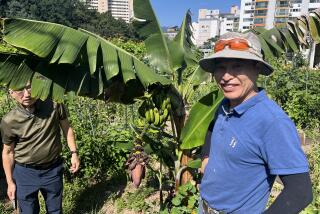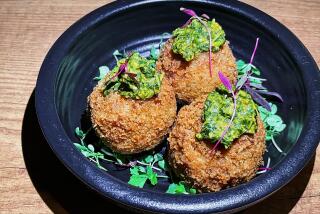Grow your own plantains, tropical cousin of the banana
- Share via
Fernando Larios eyes the stand of plantains running along one side of the Francis Avenue Community Garden in Koreatown. A large cluster of fruit, just out of arm’s reach, is almost ready.
“It’ll be two more months,” says Larios, who has been keeping an eye on these plantains since someone poached the last cluster.
Once the fruit is harvested, the entire plant will be cut down to the ground, and others will rise up, he says. Most of the plant’s energy is underground, and pups will sprout up around the mother plant.
Plantains are part of the Musa genus, making bananas their sweeter cousin. Technically, banana plants are the world’s largest herbs, and their fruit are berries. New plants are to be transplanted in the spring; flowers, if not fruit, follow in about 10 months. Successive generations that emerge from the ground will produce fruit year-round if the conditions are good.
Growing plantains is just like growing bananas. Whereas bananas produce sugar, plantains produce starch. Plantains are a hybrid of two banana species (Musa acuminata crossed with Musa balbisiana) and are nearly always served cooked. They can be treated like a potato: fried, baked, boiled, steamed.
In the garden, basic care includes planting in well-draining soil, watering regularly and protecting from wind and frost. High winds, even warm Santa Anas, will trash the leaves and potentially topple a shallow-rooted mature plant. The plants can get tall quickly and may need to be propped up.
The California Rare Fruit Growers’ advice includes planting with a lot of compost and watering deeply to leach out hard water salts. It’s almost impossible to drown them. Established plants need to be watered deeply and slowly at least once a week (minimum twice weekly during hot spells).
“Short of being in a riverbed where it never dries out, I don’t think anybody’s ever going to over-water a banana,” said Jon Verdick, owner of Encanto Farms Nursery, specialists in figs and bananas.
Plantains and bananas are heavy feeders and appreciate a monthly feeding of a balanced fertilizer.
Encanto grows nearly 100 sweet banana cultivars but no plantains. Verdick says he thinks it’s too cold at his nursery, six miles east of downtown San Diego. Plants ordered online that come from outside California must be certified nematode-free and will most likely hail from Florida.
Once here, plantains in Southern California do well in spots with warm ocean breezes. The plants can be used as fast-growing annual ornamentals that get 10 to 20 feet high and, when mature, send out a bulbous purple bud. When it opens, a burst of white flowers appears, positioned in the pod like teeth. Only 10 rows of the flowers are fertile and will develop fruit.
The Global Garden, our series looking at multicultural L.A. through the lens of its landscapes, appears here on Tuesdays.
For easy way to follow the L.A. scene, bookmark L.A. at Home and join us on Facebook, Twitter and Pinterest.






